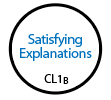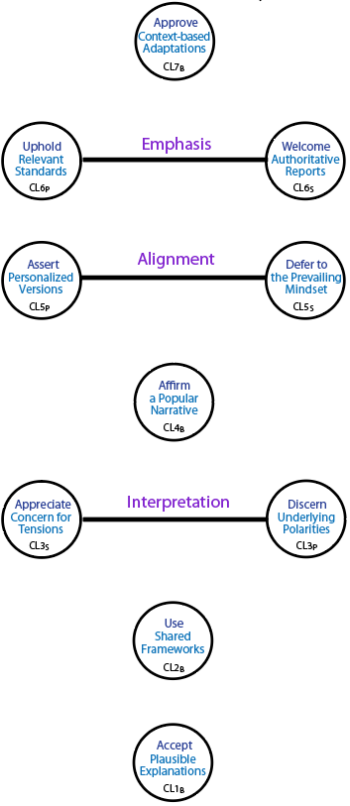Centres for Clarification to Fit In
To create the , modes are first treated as levels, and then their essences are considered in terms of practical activities and group expectations. The activities in this case is about clarifying for yourself, offering or exposing an account of a situation, and handling your group's perception of the situation.
In this process, the dynamic duality will come into play and we must determine whether the mode essence is primarily determined by personal pressures or by group pressures, or by a fusion of those two poles of the duality. The analysis will proceed level by level starting from below.
Causal Foundation: CL1
Saying nothing, being satisfied by accepted by your group, and offering that are plausible appear to be fundamental to fitting in to your relevant group. Any explanation must be simultaneously plausible for you as well as being socially satisfactory. If the group explanation is referred to as “what they would say”, then the person is distancing themselves and is on the path to self-exclusion. Openly and regularly challenging explanations that the group finds plausible reveals a lack of fit.

So, in the Tree, this level becomes a single balanced Centre: .
We will label :
Structural Control: CL2
are developed to be shared. Models of a situation must be useful and meaningful for both individual members and the group. Anyone who does not master or use or refer to a framework or model in the same way as those around him will clarify and conclude things differently to others. Arguments will develop and such individuals will not fit in. It seems that the two poles must be fused in practice.

So, in the Tree, this level becomes a single balanced Centre: .
We will label :
Dualistic Tensions: CL3
exist in all situations based on divisions of interests and differing values of those involved. Strong disagreements and persistent disputes are concerning and appear in media reports and part of general conversation. Individuals would not feel it necessary to dissent from these rather superficial observations, nor would agreement to the presence of tensions be any sort of personal commitment. Group members should understand why concern exists.
Individuals who have studied the history of tensions in this and related situations are likely to identify and emphasize an underlying polarization. While others may not wish to see that division or may not fully comprehend its intensity, such ignorance or disagreement would not prevent an individual affirming the polarization.
This means that this level in the Tree will generate two polarized but connected Centres: and .
We will label :
and label :
Tensions can erupt and recede as times change, while any underlying conceptual or ideological polarization is an enduring feature of the situation. So the Centre is dominant and placed on the right side of the Tree.

Dynamic Evolution: CL4
Based on an analysis of interactions and the historical evolution of the situation, one or more can be constructed. The aim is to create a sense of realism so as to shape the way people think, and that is why factions competing for support develop their own narrative.
Each person wants to hold a narrative in mind that suits them, but to fit in they must choose from one of the available narratives. A unique personal narrative with its emergent scenarios cannot coexist in practice with a completely different narrative held by the group. That means the same narrative will be recognized by members and by the group as a whole.

So, in the Tree, this level becomes a single balanced Centre: .
We will label :
Atomistic Mind-Sets: CL5
Every one responds to situations and any given narratives in terms of their current way of thinking, which can be called an outlook or mind-set. Mind-sets are characteristic of both individuals and groups: so there are two types of ownership.
For an individual, assimilation of the narrative leads to a personalized version of any situation and the group is not involved directly here. However, any group, community or wider society, has ways of thinking about things that are generally recognized. Popular mindsets affect interpretations of relevant events and everyone needs to be aware of the current outlook as a matter of tact and good manners.
This means that this level in the Tree will generate two polarized but connected Centres: and .
We will label :
and label :
The prevailing mindset, being more predictable, enduring and general, unites people and can shape or even over-shadow any person's particular version. So the Centre is dominant and placed on the right side of the Tree

Unitary Standards: CL6
Groups want any form of clarification to conform to well-established and systematically applied standards of evidence, reasoning and other established rules or principles. Otherwise the explanation will be doubted and even deemed invalid. Versions of the situation that have been developed and revised in these terms become authoritative for the group and its members.
Individual members, independently of the group, can determine which standards are relevant and apply these to any accounts that are generated, even authoritative reports.
This means that this level in the Tree will generate two polarized but connected Centres: and .
We will label :
and label :
Authoritative reports by the group are more influential than particular members who may choose independently to actively uphold standards. So the Centre is dominant and placed on the right side of the Tree.


Unified Adaptation: CL7
Context-based adjustments are made at the time and place of application of any account. The group as a whole has to accept the adjustments. Each person in the group must be confident about that same adjustment in order to belong and participate in activities.
While a person on their own might well make changes to fit their particular context, this is simply a group of one. In other words, there cannot be both an individual adjustment and a different group adjustment for the same context because this would generate confusion and conflict.

So, in the Tree, this level becomes a single balanced Centre: .
We will label :
-------------------------------------------------------------------------------------------
-
Having identified the 10 Centres in the 7 levels and the integration of the bipolar Centres at L3, L5 and L6 (as shown at right), the next step is to specify channels of influence between the Centres.
There are several ways to proceed. For this investigation, the focus will commence with:
► Channels to and from the two Centres that appear to be at the heart of any social consensus and essential for fitting in.
All channels feeding into a
All channels feeding into the► Then, the two peripheral channels, left-sided and right sided, moving from at the top down to at the bottom.
► Finally the inappropriateness of additional direct links are checked here.
-
Jump ahead and see the completed Tree with all channels named.
Originally posted: 10-May-2025. Last amended: 5-Oct-2025.